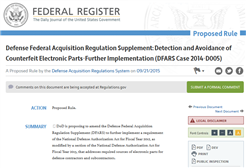DoD Casts A Wide Net To Catch Counterfeit Parts; DFARS Case 2012-D055; Detection and Avoidance of Counterfeit Electronic Parts
Kristal Snider
ERAI, Inc.
In the last few years there has been a flurry of legislative activity relative to counterfeit electronic parts in the DoD supply chain. In 2007 concerns were raised by the U.S. Department of the Navy, Naval Air Systems Command (NAVAIR) who asked the Bureau of Industry and Security’s (BIS) Office of Technology Evaluation (OTE) to conduct a defense industrial base assessment of counterfeit electronics. NAVAIR had reason to suspect an increasing number of counterfeit and defective electronics were entering the DoD supply chain, which would adversely impact weapon system reliability. NAVAIR’s suspicions were confirmed. The BIS study titled “Defense Industrial Base Assessment: Counterfeit Electronics” was published in January 2010. The report’s findings prompted a swift response from Senators Carl Levin and John McCain in March 2011 when they launched a deeper investigation into counterfeit electronics part activity via the Senate Armed Service Committee (SASC). In November 2011, the SASC held a hearing with DoD contractors, industry associations and others in Washington D.C. to explore the problem of counterfeit electronic parts infiltrating critical defense systems and the risk those parts pose to such systems.
Shortly thereafter, on November 17, 2011, an amendment was made to Section 818 of the Fiscal Year 2012 National Defense Authorization Act (NDAA FY 12). At its core, NDAA FY 12 seeks to stop the importation of counterfeit electronic parts into the United States, address weaknesses in the defense supply chain and promote the adoption of aggressive counterfeit avoidance practices by the DoD and the defense industry.
On September 7, 2012 a Defense Federal Acquisition Regulation Supplement (DFARS) case addressing portions NDAA FY 12 was opened DFARS Case 2012-D055: Detection and Avoidance of Counterfeit Electronic Parts).
On May 15, 2013 DoD published its first set of proposed regulations that would impose specific obligations on defense contractors representing a partial implementation of the counterfeit electronic parts prevention requirements described in NDAA FY 12.
After obtaining comments from industry experts, interested parties, and the private sector, a revised draft notice was published on September 21, 2015 in the Federal Register. DFARS Case 2012-D055: Detection and Avoidance of Counterfeit Electronic Parts
ERAI encourages its Members, including those in the commercial sectors, to follow closely the government’s rule making activity as these regulations may have far-reaching implications for the supply chain. Small businesses, lower tiered suppliers and commercial contractors are now within the government’s widely cast net. The earlier proposed regulations only applied when the contractor was subject to the Cost Accounting Standards (“CAS”). DoD wants to change that which means these regulations will flow deeper into the supply chain.
Once again DOD is seeking public comment and is encouraging input from “all tiers” including but not limited to subcontractors, small businesses, and suppliers of commercial-off-the-shelf (COTS) items. DOD estimates that this rule change may affect more than 30,000 small businesses alone.
Comments on the proposed rule are due by November 21, 2015.
Resources:
For regular updates on the FAR/DFAR and much more we recommend you follow Henry Livingston’s Counterfeit Parts Blog.
SEE MORE BLOG ENTRIES
|

|